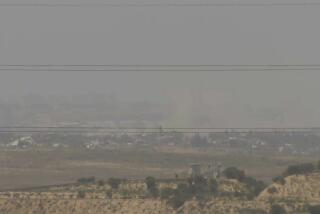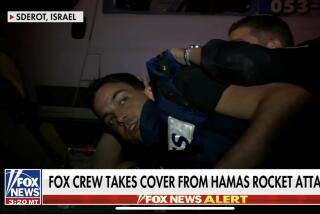News Outlets Reduce the Use of First, Searing Crash Images
- Share via
NEW YORK — ABC News President David Westin has issued a sweeping directive, virtually banning from ABC News broadcasts the most graphic video images of last week’s terrorist attacks, including footage of the jetliners hitting the World Trade Center, the resulting fireball and the collapse of the twin towers.
It is a step many news organizations--both broadcast and print--are taking in less formal ways. Westin told ABC producers Monday that the footage could be used only if it was deemed critical to the report and top executives signed off.
ABC News spokeswoman Su-Lin Nichols said the decision was not prompted by viewer calls but out of sensitivity to victims’ families and survivors and a desire not to be “gratuitous. There is a sense that we risk turning this powerful image into a kind of wallpaper.”
Westin’s directive, which anchor Peter Jennings announced on the air late Monday, was echoed in similar policies gradually being put in place at other networks, as the coverage moves on to issues of recovery and possible retaliation.
On Saturday, Fox News Channel executives limited use of the images and said producers would have to justify any decision to run them. MSNBC said it largely ceased showing the images beginning early Monday because the story had moved forward. NBC News has cut “way, way back,” a spokeswoman said, “and will use the footage only if it is germane to the story. The story has moved on.”
CNN said it was using the images judiciously, but they could still be seen several times Tuesday afternoon, including as part of the station’s on-air ads promoting its coverage. At CBS News, a spokeswoman said the video “is still available for pieces, but I haven’t seen too much of it lately.”
Although television faces unique issues because of the visual impact and immediacy of its images, print publications are also changing their pictorial approach. Newsweek editor Mark Whitaker said he thought his magazine would “use newer pictures of what’s happening now,” rather than photos from the first day’s destruction. But he declined to rule out using those early photos if, “at some point, we do a retrospective on this.”
“As the authorities allow more access to ground zero, we may see more gruesome pictures, of body parts and such,” Whitaker said, “and while we . . . try not to sugarcoat things, there is always a taste line and we sort of judge that as we go along.
“In this case, some very experienced public officials who have seen a lot have emerged from the scene [of the attacks] incredibly distraught and shaken up,” he said. “We may never see the images of what they saw, but if we do, a lot of us in the press are going to have to think long and hard about how to handle them.”
Howard Chua-Eoan, assistant managing editor of Time magazine, said Time was using few images of the initial impact and destruction because they seemed less newsworthy now.
“We haven’t had any conversations about what specific images we should or should not use,” he said. “But every now and then, a particularly graphic image will come along, and we’ll decide on a case-by-case basis.”
Time has “scribbled out the phone numbers” that appear in photos of signs and placards carried by people looking for missing friends and relatives, he said, “so we don’t make it possible for people to play cruel hoaxes on them.”
At most newspapers, competition for space is much greater than on the 24-hour news networks. On a story developing this quickly and on as many different fronts, there is often not enough room for much new material, let alone photos from the first day.
Photos in a newspaper, or even a magazine--no matter how vivid and dramatic--don’t have the same impact as moving pictures on a television screen. Bob Dubill, executive editor of USA Today, said he can “certainly understand the concern that TV has about this.”
“We always try to exercise good taste and judgment,” he said, “but we take it on a day-to-day, case-by-case basis. . . . And in the appropriate story and context, those [early] photos could be very germane.”
Jensen reported from New York and Shaw from Los Angeles.
More to Read
The biggest entertainment stories
Get our big stories about Hollywood, film, television, music, arts, culture and more right in your inbox as soon as they publish.
You may occasionally receive promotional content from the Los Angeles Times.










